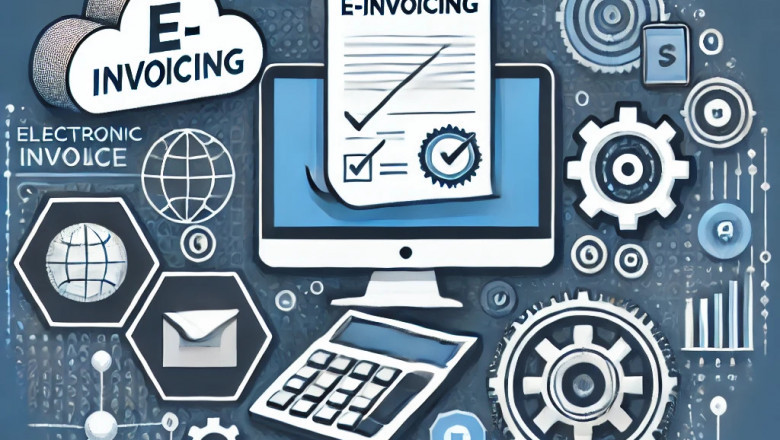views
E-invoicing, or electronic invoicing, has rapidly become a critical aspect of modern business operations worldwide. As companies aim to streamline processes, improve accuracy, and meet regulatory compliance, e-invoicing offers an efficient solution. This guide provides a deep dive into the concept of e-invoicing, its benefits, implementation, and global adoption trends. By the end, you’ll have a clear understanding of why e-invoice is essential for businesses in today’s digital landscape.
What Is E-Invoicing?
E-invoicing refers to the process of issuing, transmitting, and receiving invoices in a digital format. Unlike traditional paper-based invoices or PDFs sent via email, e-invoices are structured data files that are exchanged directly between the accounting systems of the buyer and seller. These invoices comply with specific formats, often dictated by regulatory requirements, ensuring seamless integration and processing.
Key Features of E-Invoicing:
-
Standardized Formats: E-invoices are typically generated in XML, JSON, or other structured data formats.
-
Automation: They enable automated data extraction and processing, reducing manual intervention.
-
Compliance: E-invoices meet legal and tax regulations, varying by country.
-
Real-Time Validation: Some systems provide real-time checks to ensure accuracy and compliance before submission.
Benefits of E-Invoicing
Adopting e-invoicing brings numerous advantages for businesses. Here are the primary benefits:
1. Improved Accuracy
Manual data entry often leads to errors in invoices, causing delays and disputes. E-invoicing eliminates human error by automating data processing, ensuring accuracy in every transaction.
2. Cost Efficiency
Paper-based invoicing involves printing, postage, and storage costs. Switching to e-invoicing significantly reduces these expenses. According to studies, businesses can save up to 80% per invoice when using electronic systems.
3. Faster Payments
With automated processes and quicker invoice delivery, payment cycles are shortened. Some systems even integrate with payment gateways, enabling instant transactions.
4. Regulatory Compliance
Many countries mandate e-invoicing to enhance transparency and reduce tax fraud. Using an e-invoicing system ensures your business remains compliant with these regulations, avoiding penalties.
5. Environmental Benefits
E-invoicing reduces paper usage, contributing to sustainability goals and reducing your business’s carbon footprint.
How E-Invoicing Works
Understanding the workflow of e-invoicing is essential to appreciate its efficiency. Here’s a step-by-step overview:
1. Invoice Creation
The seller generates an invoice using an e-invoicing system. This invoice contains structured data in a format compliant with local regulations.
2. Validation
The invoice is validated by the e-invoicing platform to ensure all mandatory fields are correctly filled and meet compliance requirements.
3. Transmission
Once validated, the invoice is transmitted electronically to the buyer’s system via secure channels, such as APIs or electronic data interchange (EDI).
4. Processing
The buyer’s system automatically processes the invoice, matching it with purchase orders and approvals.
5. Archiving
Both parties store the invoice in digital archives for future reference and audits, as required by law.
Global Trends in E-Invoicing
E-invoicing adoption is growing globally, driven by government mandates and the benefits of digitization. Here are some notable trends:
1. Mandatory E-Invoicing Regulations
Countries like India, Italy, Brazil, and Mexico have implemented mandatory e-invoicing for certain businesses. These mandates aim to increase tax compliance and reduce fraud.
2. Peppol Network
The Pan-European Public Procurement Online (Peppol) network is gaining traction in Europe and beyond. It provides a standardized framework for e-invoicing, ensuring interoperability across borders.
3. Real-Time Reporting
Governments are increasingly requiring businesses to report invoice data in real-time to tax authorities. This trend enhances transparency but also necessitates robust e-invoicing systems.
4. Integration with ERP Systems
Modern e-invoicing platforms integrate seamlessly with Enterprise Resource Planning (ERP) systems, streamlining end-to-end financial workflows.
How to Implement E-Invoicing in Your Business
Transitioning to e-invoice requires careful planning. Follow these steps to ensure a smooth implementation:
1. Understand Local Regulations
Research the e-invoicing requirements in your region. For example, in the UK, businesses must comply with Making Tax Digital (MTD) regulations, while in the US, e-invoicing is encouraged but not yet mandatory nationwide.
2. Choose the Right Software
Select an e-invoicing solution that aligns with your business needs. Look for features such as compliance support, integration capabilities, and user-friendliness. Popular options include:
-
SAP Concur
-
Zoho Invoice
-
QuickBooks Online
3. Integrate with Existing Systems
Ensure the e-invoicing platform integrates with your current accounting or ERP system to avoid disruptions.
4. Train Your Team
Provide comprehensive training to employees on using the new system. Highlight the benefits and address any concerns to ensure buy-in.
5. Monitor and Optimize
Regularly review the performance of your e-invoicing system. Gather feedback from users and make necessary adjustments to improve efficiency.
Challenges of E-Invoicing and How to Overcome Them
While e-invoicing offers numerous benefits, businesses may face challenges during implementation. Here’s how to address them:
1. Compliance Complexity
With different regulations across countries, staying compliant can be daunting. Solution: Work with a provider that offers region-specific compliance updates.
2. Integration Issues
Legacy systems may not be compatible with modern e-invoicing platforms. Solution: Invest in middleware or APIs to bridge the gap.
3. Resistance to Change
Employees may be hesitant to adopt new technologies. Solution: Highlight the benefits and provide hands-on training.
4. Cybersecurity Risks
Digital transactions are vulnerable to cyber threats. Solution: Use secure platforms with robust encryption and authentication protocols.
The Future of E-Invoicing
The e-invoicing landscape continues to evolve, with exciting advancements on the horizon:
1. AI and Machine Learning
Artificial intelligence will enhance data analysis, error detection, and predictive insights in e-invoicing systems.
2. Blockchain Technology
Blockchain can ensure transparency, security, and immutability of invoice data, fostering trust between parties.
3. Global Standardization
Efforts to create universal e-invoicing standards will simplify cross-border transactions and reduce complexity.
Conclusion
E-invoicing is transforming the way businesses handle transactions, offering unparalleled efficiency, accuracy, and compliance. By understanding its benefits, staying informed about global trends, and implementing the right strategies, your business can thrive in the digital age. Whether you’re a small enterprise or a multinational corporation, adopting e-invoicing is a step toward a smarter, more sustainable future.






















Comments
0 comment